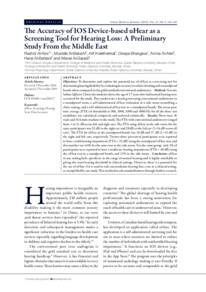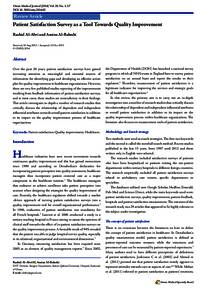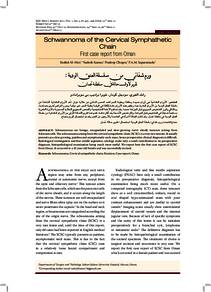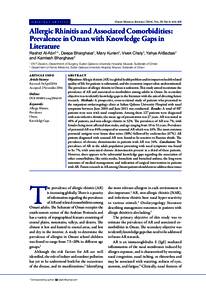Document
The accuracy of IOS device-based uHear as a screening tool for hearing loss : a preliminary study from the Middle East.
Identifier
DOI 10.5001/omj.2016.27
Contributors
Al-Balushi, Mustafa., Author
Kolethekkat, Arif., Author
Bhargava, Deepa ., Author
Al-Alwiyah, Amna., Author
Al-Bahlaniyah, Hana., Author
Al-Garadiyah, Manal., Author
Publisher
Oman Medical Specialty Board.
Gregorian
2016-03
Language
English
Subject
English abstract
Objectives: To determine and explore the potential use of uHear as a screening test for
determining hearing disability by evaluating its accuracy in a clinical setting and a soundproof
booth when compared to the gold standard conventional audiometry. Methods: Seventy
Sultan Qaboos University students above the age of 17 years who had normal hearing were
recruited for the study. They underwent a hearing test using conventional audiometry in
a soundproof room, a self-administered uHear evaluation in a side room resembling a
clinic setting, and a self-administered uHear test in a soundproof booth. The mean pure
tone average (PTA) of thresholds at 500, 1000, 2000 and 4000 Hz for all the three test
modalities was calculated, compared, and analyzed statistically. Results: There were 36
male and 34 female students in the study. The PTA with conventional audiometry ranged
from 1 to 21 dB across left and right ears. The PTA using uHear in the side room for the
same participants was 25 dB in the right ear and 28 dB in the left ear (3–54 dB across all
ears). The PTA for uHear in the soundproof booth was 18 dB and 17 dB (1–43 dB) in
the right and left ears, respectively. Twenty-three percent of participants were reported
to have a mild hearing impairment (PTA > 25 dB) using the soundproof uHear test, and
this number was 64% for the same test in the side room. For the same group, only 3% of
participants were reported to have a moderate hearing impairment (PTA > 40 dB) using
the uHear test in a soundproof booth, and 13% in the side room. Conclusion: uHear
in any setting lacks specificity in the range of normal hearing and is highly unreliable in
giving the exact hearing threshold in clinical settings. However, there is a potential for
the use of uHear if it is used to rule out moderate hearing loss, even in a clinical setting,
as exemplified by our study. This method needs standardization through further research.
Member of
Resource URL
Category
Journal articles







